The Bahamas Shake Up Shake Down cruise revealed that we needed to revamp our electrical system to make it designed for us to be able to anchor out the majority of the time, unlike FLUKE'S previous cruising life which was spent primarily at docks. So, we took care of that with just time (almost a month) and money ($12,000), both of which we felt we really couldn't afford. We added another $800 worth of food to make the boat sit lower in the water, burn even more high priced fuel, and decided to cast the lines from the home dock and hit the waterway.
As the shuttle Discovery was scrubbed on July 1, so was our departure day as the marine electrical technician had to work until 7:00 pm on June 30 to finish our job, and we just couldn't up and leave the next morning without testing some of his work.
VERO BEACH, FL TO WACCAMAW RIVER, SC
RUNNING AWAY FROM HOME-HERE WE COME TOM, SAWYER THAT IS!
We managed to leave after lunch on July 2, better than waiting until July 3. We dropped anchor at 7:00 p.m. south of the 520 Cocoa Beach causeway. We had to weave through a large number of crab traps - they were everywhere off the ICW. It was either the crab trap area or else having to weave between several spoil areas (they were underwater), so at least we could see the traps and not run aground on the unseen spoil areas. This area is near Tropical Trail on Merritt Island. As the name suggests, the area really does look tropical and is very beautiful with dense foliage. As dusk was approaching Wayne asked me what was the noise coming from the land that sounded like howler monkeys! When I listened closely I realized the loud cawing sounds were those of peacocks calling to each other. Those sounds put us to sleep, this the first night of our journey.
MAN VS NATURE
On July 3 we had the anchor up by 06:50 and were back on the waterway. Our original intent was to head out the Canaveral Barge Canal and make a run out in the ocean to Charleston. However, we and FLUKE weren't ready: we were pretty tired to do an overnight crossing in the ocean and a lot of things still hadn't been properly stowed or secured on the boat. Plus, we would have some restrictions to deal with in going through the Launch Hazard Area (LHA) which is established for space craft launches originating from Cape Canaveral. The LHA extends all around the Space Center as well as out into the ocean, restricting all vessels from entering the area for a certain time period before and after launches. The Coast Guard maintains watch and continuously posts notices to mariners on the VHF.
The inside passage is just fine for boats who travel slowly anyway, as evidenced by the grand day we had. We were traveling through the Merritt Island National Wildlife Refuge, which the Space Center sits on. It is a birders dream. We saw many wading birds, two of my favorite species being Roseate Spoonbills and Reddish Egrets, the former with bright pink plumage contrasting to the almost chartreuse green of the marsh grass and the latter with its mauve colored plumage and dancing feeding strategy.
When going through the Haulover Barge Canal (manmade) which connects the Indian River Lagoon to the Mosquito Lagoon, we saw several manatees, some of which were mating causing them to come up very far out of the water.
We were able to see the VAB at the Space Center with the colorful NASA logo and gigantic American flag. The space shuttle Discovery was visible on its launch pad, its majesty of size and power being muted by the shimmering waves of heat rising off Mosquito Lagoon and the stillness of nature's beauty all around.
We were anxious to find a place to anchor for the night as it was the holiday weekend, and we were worried that spaces would be limited, especially because the destination we had in mind was near Daytona Beach, a place called Rockhouse Creek (a tributary of Ponce Inlet). Many tributaries of the main waterway have strange names, whose origins may probably only be known by ancient locals. I will be using such names as FLUKE finds safe havens during the move northward.
Space was limited, but at least most of the couple of hundred boats around the area were day boats who had beached themselves for swimming and picnics. We set our bow anchor, but were in a narrow, swiftly flowing channel which we knew would would have a current change totally in the opposite direction once the tide changed which necessitated we put out a stern anchor too.
Since space for maneuverability was limited, Eddie volunteered to take our stern anchor out and set it by hand. Navy Seals are trained to carry 35 lbs in the water without complaining. Eddie was never in ANY branch of the military, much less a Seal, so we needed a plan to minimize his complaints and maximize his efficiency. We rigged up 2 life preservers and tied the anchor to them. Eddie, a.k.a. as Lloyd Bridges, donned his flippers for extra power against the strong current and left the ship. Unfortunately, he couldn't get as far as we liked, but we decided to make do as he was quickly running out of thrust. Man wins that battle with nature, but we were soundly defeated the following morning as we were eaten alive by millions of no-see-ums as we pulled up the anchor.
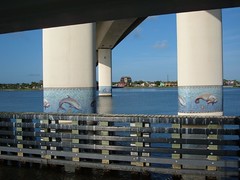
Mosaic Tiles on Bridge in Daytona Beach
Man's engineering skills were showcased as we passed through the ornately decorated Bridge of Lions in St. Augustine (said to be the most beautiful bridge on the ICW), saw the temporary bridge underconstruction (it will be used while the BoL is getting a makeover), passed by Castillo de San Marcos, the fort built by the Spanish in 1672 to defend their city, and saw the space shuttle Discovery launch into the sky all within minutes on this, our nation's birthday, July 4, 2006!
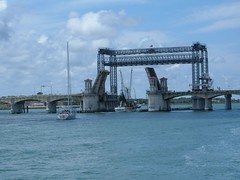
Passing Through the Old and New Bridges in St. Augustine
The fort's walls and grounds were covered with people cheering and clapping with their eyes to the sky, real witnesses to contrasts in time and technology. We had to carefully pass a large barge laden with fireworks anchored off the fort which would provide a grand finale to an exciting day. The ghosts of those proud Spaniards of time past were pleased with what they had started! FLUKE rested that night in the open marsh lands north of St. Augustine where we could see fireworks in the distant clear night sky, but still experience the solitude of nature.
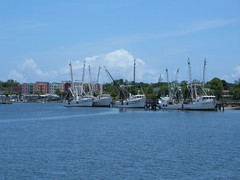
The Shrimp Fleet in Fernandina Beach, FL
CHECKING ON YOUR TAX DOLLARS AT WORK
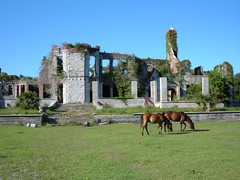
Wild Horses at Dungeness Ruins
Finally we go ashore at one of my longed for destinations - Cumberland Island National Seashore. The island is only accessible by boat and has no paved roads. It is a nature lover's paradise. We managed to anchor and get to shore by 5:00 p.m., a time that turned out to be in our favor for wildlife viewing. We saw many of the wild horses that inhabit the island. They are descendants of what were called marsh tackies, work horses that were let loose to roam the marshes to freely graze during the winter and then rounded up in the spring and fall to use for farming. In the 1920s a trainload of wild mustangs was relocated from Arizona and released and the offspring of the genetic mixing of those 2 groups still roam the island wilds today.
We also saw armadillos, deer, and a large flock of wild turkeys with the longest waddles I've ever seen! It isn't just the wildlife that is so appealing: the vegetation is just outstanding, from the maritime forest composed of towering Spanish moss draped oak trees to the hilly dunes with their wiry and windswept coastal plants that give way to the grand expanse of the open seashore and Atlantic Ocean.
If you don't want to try to trudge through the soft sand of the dunes, sturdy boardwalks take you over marsh and wetlands and let you see the dramatic landscapes of the coastal tidal plains and the creatures that inhabit them.
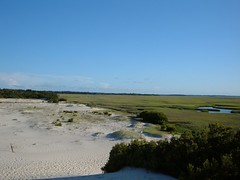
Where the Marsh Meets the Dunes, Cumberland Island
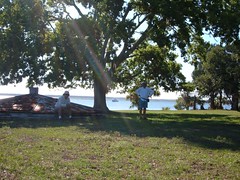
Wayne, Eddie, and FLUKE (in background) at Cumberland Island
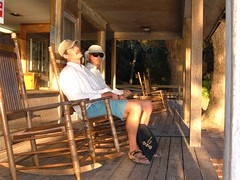
Resting at the Ranger Station, Cumberland Island
The ruins of Dungeness Plantation, a stately mansion from society's yesteryear, that belonged to the brother of industrialist Andrew Carnegie, is fascinating to visit. The huge, stately magnolia trees with their extremely fragrant blossoms add a magical touch to the air to really make you feel like being back in time, expecting to see a horse-drawn carriage coming up to the grand entrance gate of the mansion.
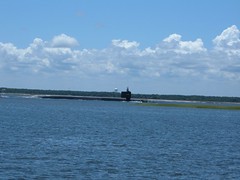
Technology and Nature Meet, Cumberland Island
We knew we weren't back in time though when we heard the rat-tat-tat of the Coast Guard chopper flying low overhead with a coastguardsman leaning out the open door with a pair of binoculars carefully checking us out as we peered overhead from our little haven, FLUKE. Then we saw the armed gunboats go racing by and heard the chatter on the VHF about the navy "vessel" entering the St. Mary's inlet right in front of where we anchored. Silently from around the corner of the inlet, the sleek gigantic nuclear submarine slid slowly into view. We watched in wonder as the sub passed and waited for its wake to rock us back and forth. Kings Bay Submarine Base was just around the corner from where we rested. The night sky glowed from the lights of the base, and we knew, or thought, Homeland Security was keeping us safe.
BY JOVE, THAT WAS TOO CLOSE!
Fortunately we planned to get a late start pulling up anchor to catch an incoming tide through St. Andrews Sound to give us a smoother ride and more water for the shallow crossing. We were delayed from moving because another nuclear sub came in the inlet, and we were going to go by the sub base and couldn't use the waterway until the area was declared clear. We had a short day to another anchorage in the middle of a marsh called Jove Creek. We hurried to set the anchors in place as the sky was darkening quickly with a fast-approaching thunderstorm. Eddie, now taking another moniker, Grillmaster, was off the hook for having to grill the pork tenderloin that was on the menu as we wanted to have more controlled cooking on the grill rather than a quick jolt from a bolt. We just sat out in the open with the lightening bolts spearing down around us (maybe it really is Jove's creek and we weren't welcome).
The next morning, we got a call from another cruising boat we had been talking to for the last couple of days who had anchored south of us and from their vantage point it looked like we could have been hit by lightening. Thank you, not us, this time, but it is always a possibility. As long as you can hear the thunder, you are still OK!
The salt water washdown ceased operating right as we raised the second anchor. Upon investigation into the forward hold (which I refer to as the sewer since that's where the holding tank is), Wayne had to quickly grab a fire extinguisher as the washdown pump was really smoking. We should have known a problem was pending as we had noticed a small leak in it the day before. Relatively speaking, by boating standards, leaks are better than fires, but neither is really great and remedies can be costly and time consuming. After the pump, and we, cooled down, we got all the info off the label of the pump and called the manufacturer to find out about availability of getting a replacement. One was available, so on this, July 7, the 5th day into our voyage we were faced with our first major expense. BOAT (Break Out Another Thousand) proved itself to be true again as the replacement pump is $900 and we will have to go to a marina (we made arrangements to have it sent to a marina in SC we think we can get to in 4-5 days) to get the part and make the repair. We will be able to do this ourselves, as we do most repairs, or else we couldn't afford to have FLUKE and pay someone else to tend to her delicate needs. So, we pulled into Moon River (near Skidaway Island) for the night and added more salt to our wounds by taking 1.5 hrs to set the 2 anchors. Life was not peaceful like the song tonight. But, yes,Eddie had to grill the tenderloin anyway! The crew needs to eat.
Bringing up the anchors without a washdown pump was a dark nightmare. The stuff on the bottom isn't really mud - it's a malodorous sulfurous jello-like jet black goo called plough (pronounced pluff).That name was coined by planters of the 1800s who realized the value of it as a nutrient-rich material that they could harvest and spread over their cotton fields. FLUKE wasn't in need of any vitamin supplements, but had an overdose as the chain was hauled up and the goo oozed slowly over her foredeck, down the sides, on us and other private places. We had to haul up bucket after bucket of water (the deck is 10' up, so that's heavy lifting!) and use a brush to clean the chain 3' at a time. We couldn't put the chain in the locker (sits right above the bed!) and run the risk of having a site to rival the real sewer. It took 45 minutes to get the chain situated and longer to get the deck cleaned. Sulfur smell permeated the boat the entire day, and no matter how many times I washed my hands I thought I could still smell the goo.
FLUKE pressed onward, leaving a stinking plume in her wake, or so I envisioned. Things brightened up as we passed the old, beautiful waterfront homes outside of Savannah with their fascinating architecture and beautiful grounds. One home had a collection of hydrangeas that reminded me of a floral rainbow. It could not have been a coincidence that the fully-headed blossom colors were in order from white, to pale pink, to darker pink to hues of blues and finally deep purple.
The Intracoastal Waterway visual prize near Savannah has to go to Bonaventure Cemetery, the one made famous in both the book and the movie, Midnight in the Garden of Good and Evil. The Victorian statues, ornate tombs, obelisks, and sundry other grave markers sit amidst towering ancient oaks laden with gently swaying sprays of Spanish Moss, probably hiding the secrets of the permanent residents below. Dating back to the Civil War, this sprawling piece of picturesque waterfront real estate looks more like a park for people to enjoy the serene atmosphere and appreciate the beauty of man and nature than morn those who are buried there.
FLUKE slowly continued onward with July 8 steadily improving over its "black" morning. The day passes quickly, even at our usual slow speed of 6-8 knots, as there is so much to see and chores to tend to. Sights change and conversations strike up wondering what we are seeing on shore or on the waterway. What island has 2 gigantic water towers that only say 1-800-MARINES? Parris Island (opened 1891), home of the Parris Island Marine Corps Recruit Depot where 19,000 recruits train each year. Not far down the river is Beaufort (pronounced Bew-furt), dating back to the 1700's, with so much southern charm still apparent today. For more pop culture trivia fanatics, the movies Forrest Gump, The Great Santini, and The Big Chill were filmed here. Shrimp boats abound, and even if you don't like shrimp, you must have liked Forrest, so you can't help but be interested in this setting. Brickyard Creek is our home for tonight, a stone's throw from someone's dock, so close I can have a conversation with the owner of the home who brings her young son down to see the "ships".
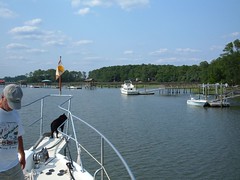
The Crew Checking the Anchor at Brickyard Creek
ROBBERS ON THE MARSH
It is on this day of July 9 that I will first begin writing the "long" version of the journey. We are floating around the busy Charleston Harbor, right by Fort Sumter, many dolphins on the bow, dodging numerous sailboats, and having to wait a whole hour for a bridge that only opens on the hour, and we just missed the hour mark. So, we are at least lucky that the weather is decent and we aren't getting knocked around like corks during the delay. Since I don't have helm duty, I can finally start my text with the intent to finish before we make the stop at the marina in a few days so this can be sent. My crewmates continuously interrupt my thoughts - it is a wonder I can get this done at all!
We make the next bridge opening on time, despite having to creep through some real shallow water. We drop our hooks right off Dewees Island in the creek by the same name. Dewees Island is a private development that is only accessible by water, and the residents have a private charmingly constructed ferry to take them and their belongings back and forth to the mainland. They get around the island by golf carts, some of which are pretty snazzy from my observations through the binoculars as we are anchored near the ferry dock, just a stone's throw from the cart storage area. Plus, it appears a lot of residents leave their carts right by the ferry dock. The well-treed island sits alone in an expanse of golden marsh grass on most sides, with a small inlet and beach coastline on the rest. There are golf courses in the middle. As the sun fades slowly in the west, I see the marsh bandits pop up their masked faces and begin their evening task of searching for food. Two of them are very close to the dumpster bins, and I'm sure those wealthy residents deposit some fine morsels in those, easy to open bins, a couple of which have already been blown over by the wind. Raccoons have to eat too: one man's junk, is a raccoon's treasure.
THAT ISN'T A LOG!
We spent most of the day inhaling mud off the bottom; the water was so shallow and we were on a falling tide. The look of the marsh land is beginning to change a bit now; there are some different types of vegetation and more uninteresting dredged channels instead of the naturally flowing river. Wayne made a quick turn with the wheel to avoid what he thought was a floating log at first, only to realize it was an alligator that dove quickly to avoid a hard nudge from FLUKE. We saw a few more. We dropped our anchors in the South Santee River, south of Georgetown, SC. There amongst the alligators and millions of mosquitoes, horse flies, and no-see-ums, we prepared to spend the night. Hearing explosions, I looked out the port to see bright blasts on the NW horizon which continued on for quite some time; I assumed they were some type of war games on, an unknown to us, military installation in the distance. Practicing to keep America safe.
FLUKE TO THE RESCUE
This is July 11, 2006, and today I am writing this real time as we are anchored for the day in Thoroughfare Creek (it connects the Waccamaw River to the Great Pee Dee River). I have caught up! Tomorrow, early in the day, we expect to pull into Wacca Wachee Marina (try saying that fast 3 times), off the Waccamaw River, near Murrells Inlet, SC. We had hoped to stop at Georgetown to see the town today as it is the 3rd oldest city in SC and seemed like it might be an interesting place to visit. It started out as a port city, dating back to 1737, supported by indigo and rice production. Now the main industries are shrimping and the papermill. We slowly cruised through the town harbor, barely big enough for 2 boats to pass and couldn't find any room to drop our anchors. We smelled and saw the big, belching, ugly papermill and decided to move on and wait for a more favorable wind to visit the city. On the way into this creek we came around a bend to see 2 young men trying to get their pontoon boat out of the middle of the creek as FLUKE was looming down on them. The current was swift, and their progress was slow. I took FLUKE out of gear to give them more time. Eddie was in the stern and could hear them ask if we could give them a tow up the creek to where they would have the opportunity to try to get gas, since they were on empty. Once again, even though we were of limited maneuverability, we couldn't leave them stranded in that current that would only push them further out into the main channel, so we threw them a line and FLUKE willingly took those orphans in tow. That is the way of the crew of FLUKE.
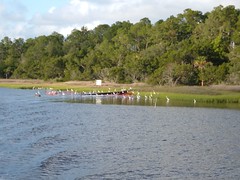
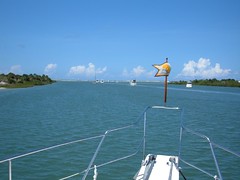
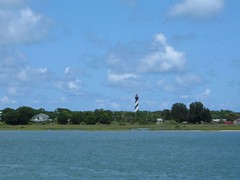
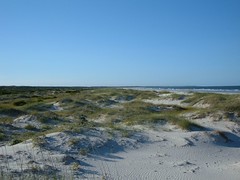








0 comments:
Post a Comment